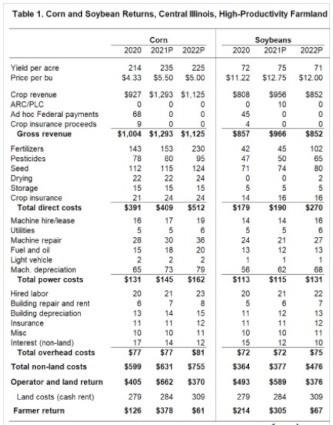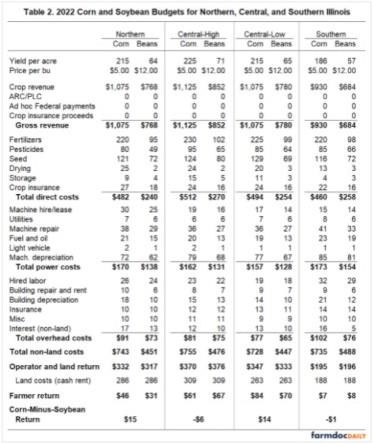By Gary Schnitkey and Krista Swanson et.al
Department of Agricultural and Consumer Economics
University of Illinois
By Carl Zulauf
Department of Agricultural, Environmental and Development Economics
Ohio State University
Illinois crop budgets for 2022 have been revised from their initial release in July (farmdoc daily, July 27, 2021). Significant changes from the initial release are increased corn prices, soybean prices, and non-land costs. The cost with the largest increase is fertilizer. Total costs will be at all-time highs in 2022. Still, we are projecting positive returns for 2022, given relatively high corn and soybean prices. Moreover, our return estimates do not suggest large changes in acres from 2021 to 2022.
Updated Budgets
Updated 2021 and 2022 projections are contained in two publications in the Management section of farmdoc. First, the 2022 Crop Budgets give corn-after-corn, corn-after-soybeans, soybeans-after-corn, soybeans-after-soybeans, and wheat budgets for four regions: northern Illinois, central Illinois with high-productivity farmland, central Illinois with low-productivity farmland, and southern Illinois. A double-crop soybeans budget also is given for all regions except northern Illinois. The second publication — Revenue and Costs for Illinois Grain Crop — shows yearly returns and costs of producing corn, soybeans, wheat, and double-crop soybeans by region of Illinois. These budgets represent average returns no matter the preceding crop and are summarized from farms enrolled in Illinois Farm Business Farm Management (FBFM).
Table 1 shows corn and soybean performance for 2020, 2021, and 2022 on high-productivity farmland in central Illinois. Similar results for northern Illinois, central Illinois low-productivity farmland, and southern Illinois are available in the Revenue and Costs for Illinois Grain Crops publication. Trends in Table 1 for high-productivity farmland also occur across regions.

Prices
In the updated 2022 projections, we are using a $5.00 per bushel corn price and a $12.00 per bushel soybean price. These projected prices were based on prices from Chicago Mercantile Exchange (CME) futures contracts. Current fall bids for 2022 cash delivery were also considered and are close to projected prices.
Many forecasters are using much lower prices for 2022. For example, during a November 29 farmdoc webinar, price forecasts were for a $4.25 corn price and an $11.00 soybean price. USDA is forecasting a $4.80 corn price and $10.50 soybean price in its preliminary long-run forecasts.
The alternative farmdoc forecast and USDA forecast are heavily based on historical supply/demand conditions. At this point, those historical relationships suggest much lower prices than are being offered by CME futures contracts. Several factors may explain this divergence:
- Supply disruptions,
- Extremely high fertilizer prices,
- Overall increases in production and land costs, and
- Prospects of inflation.
Whether prices will come down to those indicated by typical supply/demand relationships is an open question that will play out over the next year. Suffice it to say, there is considerable downside risk in the market, and lower prices will result in much lower revenues and returns.
Fertilizer Costs
Fertilizer costs in 2022 are projected at $230 per acre for corn, considerably higher than the $153 per acre costs for 2021. Fertilizer prices have skyrocketed in recent months (see farmdoc daily, October 26, 2021, November 2, 2021, and November 30, 2021). The $230 per acre does not reflect the over $1,300 high price point for anhydrous ammonia in November. We did not raise fertilizer costs to reflect the highest prices because:
- Many farmers booked nitrogen purchases earlier in the fall when ammonia prices were below $1,000 per ton.
- Fertilizer prices may decrease in the spring when many fertilizer purchases are made.
- Farmers likely will be reducing fertilizer rates.
Soybean fertilizer costs are at $102 per acre (see Table 1), up considerably from the $45 costs for 2021. These higher fertilizer costs reflect higher prices for diammonium phosphate and potash.
Uncertainty exists about whether fertilizer prices will continue at high levels. The dynamics of fertilizer prices in conjunction with movements in corn and soybean prices will influence relative profitability of corn and soybeans and acreage decisions.
Non-land Costs
Total non-land costs are projected at $755 per acre for corn, a $124 increase over the $631 per acres cost in 2021 (see Table 1). Similarly, soybean non-land costs are projected at $476 per acre, a $101 per acre increase over the 2021 level. Both corn and soybean costs will be at record levels.
Cash Rents
Cash rents in 2022 are projected to average $309 per acre, an increase of $25 per acre from the 2021 level of $284 per acre. If it occurs, the $25 per acre increase will be the second-highest, only exceeded by a $33 per acre increase in cash rents between 2010 and 1011.
There will be great diversity in cash rent increases across farms. Some cash rents will not increase, while others will have much larger increases than $25 per acre. The $25 projected increase considers these variations and gives an average.
Farmer Return
Farmer returns in 2021 are projected to be $378 per acre for corn and $305 per acre for soybeans. These returns are at record levels and will result in very high incomes in 2021.
Farmer returns for 2022 are projected at $61 per acre for corn and $67 per acre for soybeans, down considerably from 2021 levels. These per acre return levels will result in above-average net incomes based on high corn and soybean prices. However, any appreciable decline from the $5.00 per bushel corn and $12.00 per bushel soybean prices without corresponding increases in yields will result in very low incomes.
Corn versus Soybeans
Overall, corn and soybeans have about the same projected profitability in 2022: $61 farmer return for corn and $67 farmer return for soybeans, giving a difference of -$6 per acre. All regions have about equal corn and soybean returns (see the corn-minus-soybean returns in Table 2). Corn is projected $15 per acre higher than soybeans in northern Illinois, corn is projected $14 per acre higher than soybean on low productivity farmland in central Illinois, and soybeans are projected to be $1 more profitable than corn in southern Illinois.

Differences in corn and soybean returns will be influenced by corn, soybean, and nitrogen fertilizer prices. Much uncertainty exists about all three prices levels, and it is likely that there will be changes in prices moving into the spring planting season. These price changes will influence the relative profitability of the two crops. At this point, our return estimates are not suggesting large changes in acreage.
Summary
Costs will be at all-time highs in 2022. However, profitability is expected if corn and soybean prices remain high. If corn and soybeans prices fall, 2022 net farm incomes could be very low. Much uncertainty exists concerning fertilizer prices moving into spring. Those levels will have an influence over total costs for 2022.
The updated budgets result in a comparative returns situation between corn and soybeans that does not indicate acreage would deviate from recent rotations. If the difference in expected returns for the two crops widens planting decisions may be affected.
Source : illinois.edu